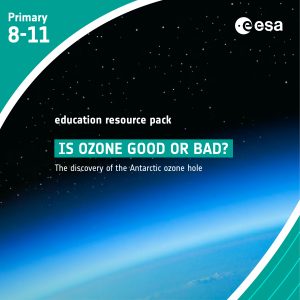Is ozone good or bad? -The discovery of the Antarctic ozone hole
In this set of three activities, students will learn about ozone and the impacts – good and bad – it has on life on Earth. The first activity gives an overview of these effects, outlines how ozone is measured and introduces the story of the Antarctic ozone hole. There is a practical activity investigating the effectiveness of sunscreen. In the final activity, students use real satellite data to explore how ozone concentration has varied across the world over the last couple of decades.
Subject Geography, Science, Earth Science
- Summarise the effects of ozone in different parts of the atmosphere on life on Earth
- Outline the story of the Antarctic ozone hole, including the role of satellite observations in monitoring its recovery
- Relate the parts of an experimental model to the real-life situation it represents
- Evaluate the effectiveness of an experimental method
- Carry out a practical activity following instructions and recording results systematically
- Use the Climate from Space web application to explore changes to global ozone concentrations
- Select key information from a range of sources to present a concise summary of independent research

- 5-6 UV-sensitive beads per group, preferably purple or dark pink (the same colour inside a group)
- Petri dish or another flat open container per group
- UV torch (optional for each group)
- Coloured pencils (same colour as beads), one for each student
- A selection of sunscreens with different protection factors
- Beakers of water – one per group
- Sharpie or another fine permanent marker
- String and sticky labels (optional)
- Towels
- A copy of Student worksheet 2 (2 pages) for each student
- Internet access
- Climate from Space web application
- Student worksheet 3
- Information sheet 3 in colour (can be one per pair of students)
- Presentation software such as PowerPoint
Did you know?
• Ground-level ozone is the principal component of smog, which is created from chemical reactions of pollutants with gases in the air.
• In 1920, Gordon Dobson, a researcher from the University of Oxford, was the first to build an instrument to measure ozone concentration from the ground.
• Many Earth observation satellites are in such orbits that they cannot take measurements directly above the North or South Pole – although they can ‘see’ everywhere else on Earth change.

Planetary Heat Pumps
Brief description In this set of three activities, students will learn how ocean circulation has an impact on climate. In...
Taking the Pulse of the Planet
Brief description In this set of three activities, students will learn how various types of electromagnetic radiation are used to...
Paxi on the ISS – Natural and artificial satellites
Brief description: Join Paxi aboard the ISS with astronaut Thomas Pesquet to discover natural and artificial satellites. Paxi on the...
After the storm – Tracking Hurricane Matthew and analysing its impact
Brief description In this set of two activities, students will explore the applications of Earth observation data in tracking hurricanes...



